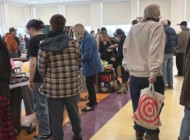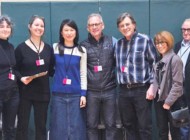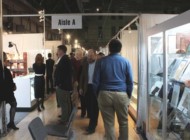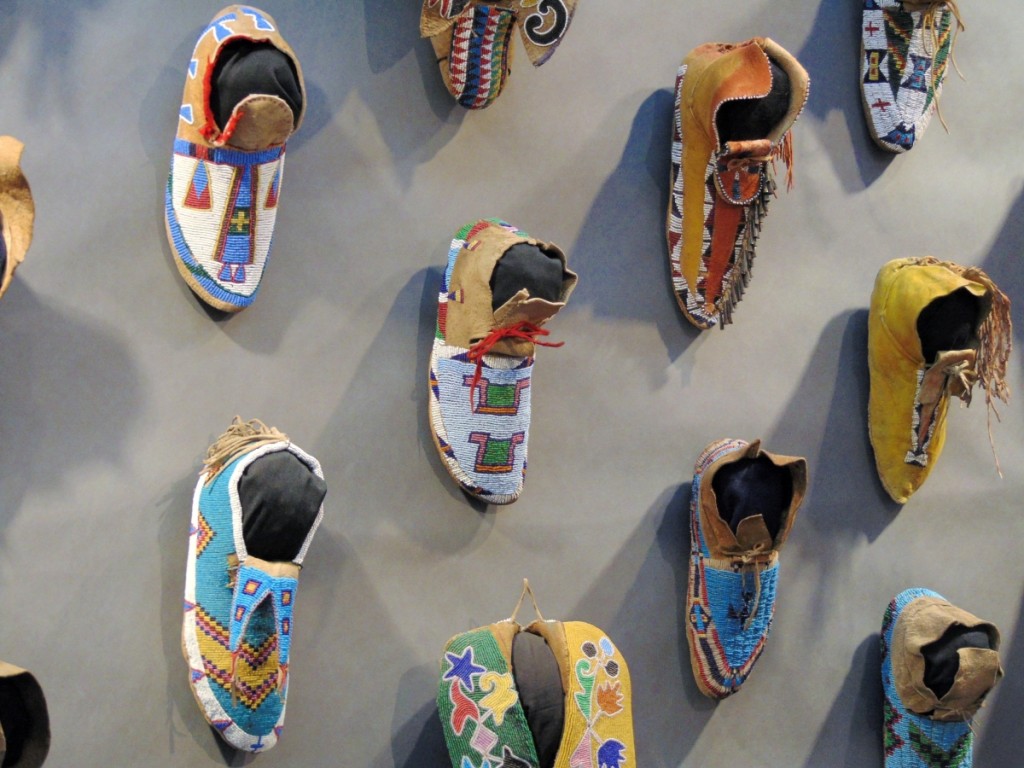
A wide-ranging montage of 20 single moccasins from the Plaines to the Southwest offered by Erich Erdoes / Buffalo Tracks Gallery, Santa Fe.
Review and Photos by Walt Borton
SANTA FE, N.M. – Celebrating its tenth anniversary, Objects of Art Santa Fe, which took place at El Museo Cultural August 9-11, continued the show’s steady progress as the most eclectic and adventuresome of the “City Different’s” important fine art occasions.
The show launched with a champagne reception on Thursday, August 8, previewing a major museum exhibit of mid-Twentieth Century designer Alexander Girard’s work, and continued with three days of novel turns.
There was serious homage to Woodstock on its 50th anniversary, including an opening night visit by Wavy Gravy’s executive chef – now photographer – Lisa Law, who, with her Hog Farm comrades, fed hundreds of thousands of rock fans on Max Yazgur’s farm in August of 1969. Visitors inevitably found themselves at a wall of important rock and roll portraits by Rolling Stone magazine’s first photographer, Baron Wolman. On Saturday, Wolman joined Objects co-producer John Morris to share recollections of three days of music and peace in upstate New York that left the world a different place. Morris was early in his 30-year career as a rock and roll producer when tapped to manage production and the stage at Woodstock.
There was great music and great art in the Parson’s Fine Art booth, but alas, no Guinness, when an impromptu fiddle and guitar session erupted featuring Robert Parsons himself, joined by fiddler Nelson Denman.
Medieval and ancient Egyptian objects mingled comfortably with whimsical folk art, fanciful textiles and elegant garb. A piece of Eleventh Century statuary presided over Santa Fe’s Bradford Old World Arts’ stall, while works from the Ptolemaic Dynasty held the spotlight at Mark Walberg’s Fine Art and Antiques, Sunbury, Penn. Bradford and Walberg were both making their first appearances at Objects of Art.
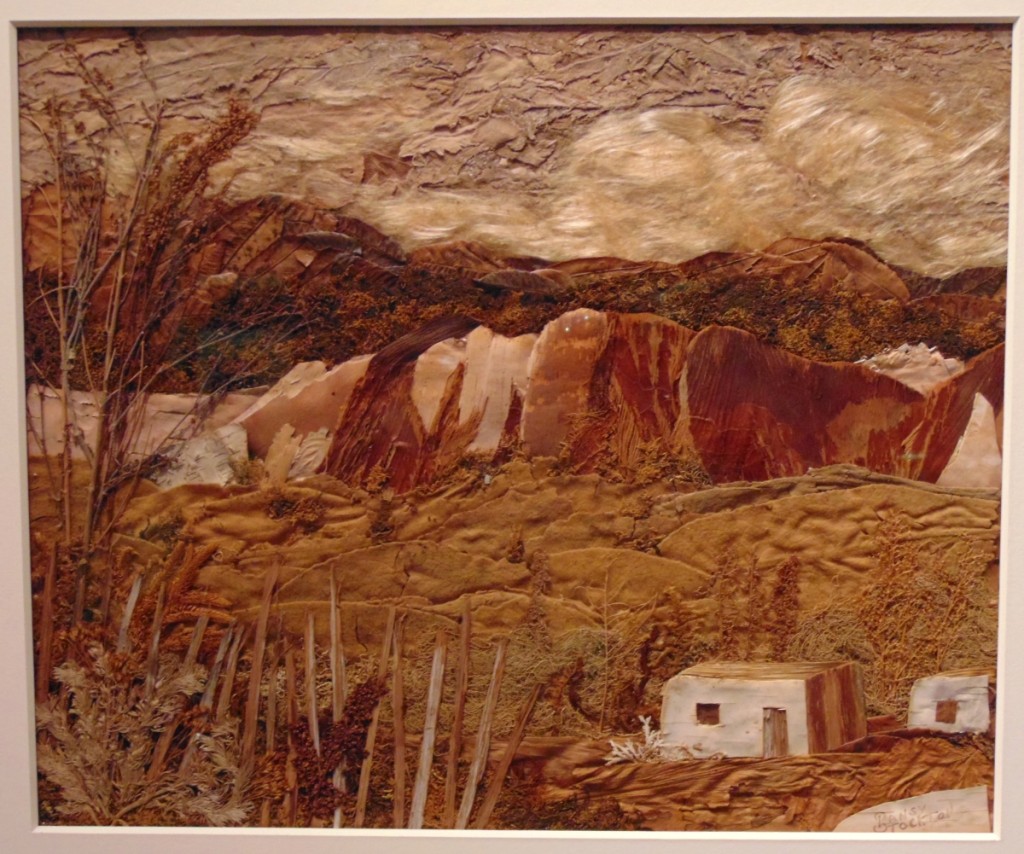
“The Pojoaque Valley, NM” by Pansy Cornelia Stockton (1895-1972). Stockton assembled botanical materials such as barks, weeds, leaves, ferns and twigs, which she used to construct realist landscapes such as this one offered by David Cook Galleries, Denver, offered for $5,500.
The show’s Asian dimension is an increasingly important aspect, and this year’s addition of Kazuo Kuwabara’s Oriental Treasure Box, San Diego, Calif., and Mark Walberg Fine Art and Antiques, made it even more so. They join Chinalai Tribal and Chinalai Contemporary, Shoreham, N.Y.; John Ruddy Textile Art, Santa Fe; Japon Gallery/Rene Sagaran, Redondo Beach, Calif.; Marie’s Amazing Asia Art, Rancho Mirage, Calif.; Tiger Tiger, Tucson, Ariz., and Haig’s of Rochester, Mich., to provide a broad range of buying opportunities in the field. The former producer of major Asian shows in New York City, San Francisco and Los Angeles, Liz Lees, also joined Objects, but she claims it’s “just for this year,” as she continues the process of de-acquisitioning decades of collecting.
Tribal art and textiles form a second major component, with Maureen Zarember’s Tambaran Gallery, New York City, and Casey Waller’s Caravanserai, Santa Fe, anchoring the floor’s center. Tambaran’s turquoise walls were the perfect background for the gallery’s well-known sculptural objects while Waller’s vibrant Middle Eastern textiles created a Bedouin-like tent seeming to need no walls at all. Strong tribal works could be found in numerous booths, including Central American objects at Venice, Calif., dealer K.R. Martindale; African works with Scottsdale, Ariz., dealer Carol Sissoko; and Skip Holbrook’s fascinating finds at Holbrook/Faircloth, Santa Fe.
As for textiles, the range and quality across the show floor was powerful. There was, of course, a strong southwestern trend, with numerous excellent Navajo weavings, to which Barry Friedman of Phoenix, added an intriguing selection of woolen Indian Trade and cotton Camp Blankets, mass-produced in the early Twentieth Century and based on Native designs by mills like Pendleton and Beacon.
The show’s custom designed and created couture is a sometimes overlooked component, but Objects embraces several of the region’s most important designers, including Danielle L. Foster-Herbst (Atelier Daniella) and Ewa Kielczewska (EWKA), both of Santa Fe. Lavish wearable art was also found at Jacquie Rice and Uosis Juodvalkis of Gild the Lily, Prescott, Ariz., Chinalai Modern and John Ruddy Textile Art.
Paintings, at the core of Objects of Art since its inception, continue to strengthen. In addition to the Nineteenth and early Twentieth Century masterworks in Robert Parson’s booth, Stephens Fine Art, Phoenix, extended that reach later into the Twentieth Century. David Cook Fine Art, Denver, Colo., and David McCullough showed prominent Western painters, while Mark Sublette’s Medicine Man Gallery, Tucson, Ariz., showed featured contemporary western painters and sculptors in addition to his signature works by Maynard Dixon. Diptych Fine Arts, Jalisco, Guadalajara, Mexico, elegantly presented a number of Eighteenth and Nineteenth Century Spanish and Spanish Colonial canvases. Robert Somers’ Blue Heron Gallery showed an exceptional Gustave Baumann, and Mark Blackburn of Honolulu included among his offerings works by Hawaiian painters too-seldom seen on the mainland.
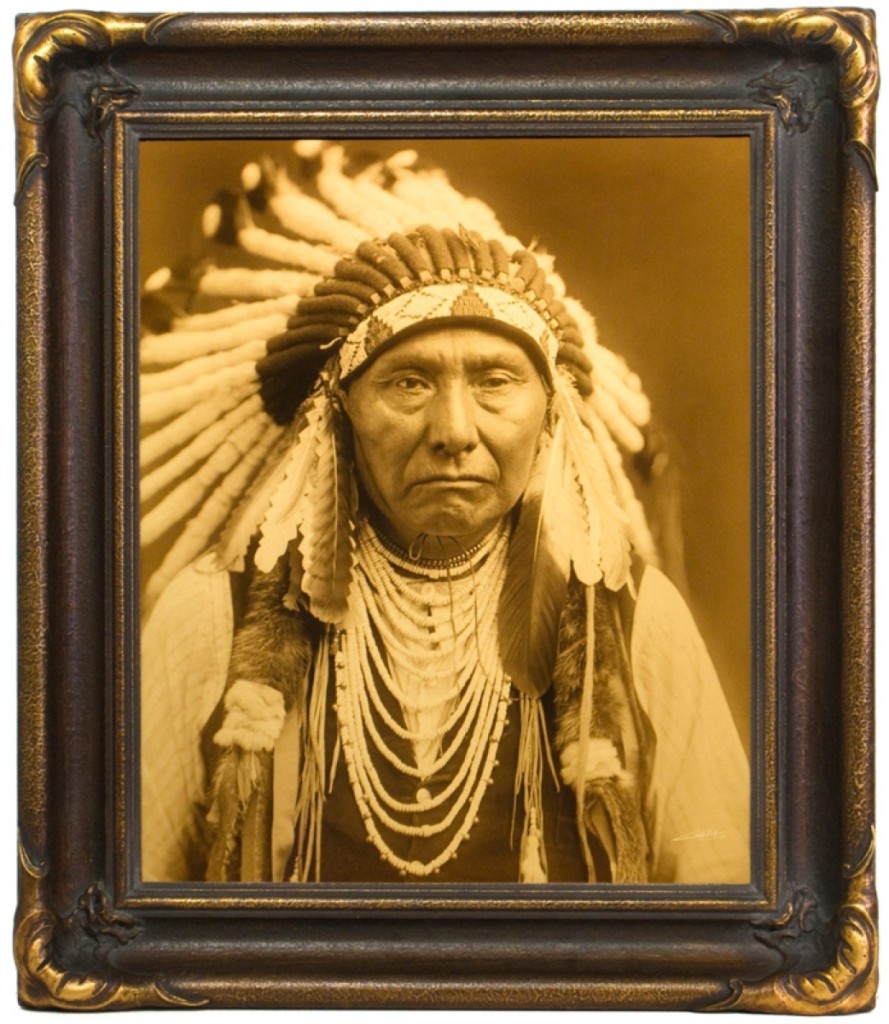
A gold tone of Edward Curtis’ portrait of Chief Joseph in ornate bat wing frame, printed by Paul Unks, Mountain Hawk Fine Art, Denver.
Photography wasn’t just about rock and roll, although there was much interest in Baron Wolman’s portraits, including one of Janis Joplin, which sold in the $1000 range. The Etherton Gallery, Tucson, Ariz., mounted a stunning show expanding its southwest regional emphasis to include images by Steve Curry shot in Pakistan and India and photographs taken in Mexico by Graciella Iturbide and Rodrigo Moya.
Objects of Art also introduced its Santa Fe audience to an important Twenty-First Century photographic project. Paul Unks of Denver, Colo., is reprinting in photogravures, gold tone and platinum photographs the work of Edward Curtis, with the blessing of the Curtis family and hard-won but growing approval from Curtis scholars and dealers. Unks’ copper plate photogravures of Curtis’ original photographs restore the works to their original photographic detail. Unks’ Mountain Hawk Fine Art gallery appeared in both the Objects of Art show and the Antique American Indian Art Show immediately following, where he lectured.
Objects of Art Santa Fe is a tour de force of design that in its early years had the potential to dissolve into a pudding without a theme. But on its tenth anniversary, its theme is concisely captured in a phrase Thomas Delach, Objects exhibitor and Early American specialist from Columbus, Ohio, once used to describe his own approach to collecting. “My criteria,” Delach wrote, “is simple yet select. It’s the design, composition, and merit of the piece.” And that is what Objects of Art Santa Fe is all about.
For information about Objects of Art Santa Fe, www.objectsofartsantafe.com.




























